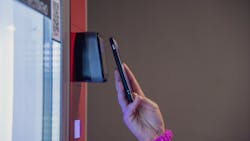Elevate the vending experience with touchless payment technology
In the last two years, how many of you have used your phone or “tapped” your card to make a payment? Prior to 2020, that number would have been rather small. However, the pandemic forced many of us to make changes in how we do things, including making purchases. Many of us started buying groceries online and choosing either delivery or pickup. In-store, others may have started using stored card information on their phones to make frictionless payments. At first, it was for hygiene reasons, but now, consumers are preferring touchless payment options simply for convenience. And that’s the key – convenience.
The vending industry is arguably the leader in consumer convenience. Whether at work, the gym or traveling, consumers have no lack of food and beverage options through vending and micro markets. But is the industry keeping up with how consumers prefer to pay?
Consumer trends
In its 2021 Back to Business Study, Visa found that more than half (56%) of consumers were using contactless payments whenever possible. Those surveyed for the study were also found to have new expectations when it comes to paying at stores. In fact, tapping a credit or debit card is the top contactless option consumers expect (62%), followed by mobile payment apps (41%) and paying with a mobile wallet (37%). According to the study, “The use of contactless payments became part of the public health response to COVID-19, but the convenience, security and reliability of those payments will no doubt reinforce long-term habits.”
Data from the vending industry, specifically, also finds these statistics to be true.
Earlier this year, Cantaloupe Inc. partnered with the Broad College of Business at Michigan State University for a joint study on payment trends in unattended retail. The study analyzed a sample set of 160,000 Cantaloupe ePort cashless devices across various segments from January 2021 to October 2021 and found that the overall share of cashless transactions increased from 51% in January 2020 to 62% in October 2021 compared to cash transactions, which decreased to 49% to 38% in the same time period. The study also found that starting in January 2020, 18% of cashless transactions were contactless.
By October 2021, contactless transactions had increased to 43% of total cashless transactions overall. In an August company announcement, Cantaloupe CEO Sean Feeney noted, “When we analyze our entire network of devices throughout the first half of 2022, we’re seeing contactless payment methods make up nearly half of all cashless transactions. And these trends aren’t slowing down. The data indicates that by the end of 2022, more than two-thirds of all transactions will be cashless, driven by consumers preferring to tap. For vending operators, this underlines the importance of offering contactless payment options if they want to increase revenue and remain competitive.”
The rise in cashless payments, the company reported, is being driven by consumer adoption of contactless payments (any payment method that uses either NFC or RFID technology to “tap to pay”), including a chip card or a mobile wallet. Based on the data, the study predicts that contactless payments will grow another 31% during 2022.
Touchless payment solutions
Manufacturers in the industry have been leading the charge by offering advanced touchless payment technologies that keep up with this change in purchasing behavior.
Cantaloupe announced earlier this year that it would integrate Vendekin’s Retrobox, a patented hardware-enabled SaaS product to make vending machines touchless and smart, supporting frictionless experiences for consumers.
Introduced five years ago, Vagabond’s vĪv touchless payment platform technology allowed its original telemetry device to take payments. “We already had a telemetry device of our own, and there were plenty of credit card options out there, and it didn’t make sense at the time for us to create a credit card reader when there were so many good options already,” said Juan Jorquera, vice president of sales and marketing at Vagabond. “So, we thought, ‘Why don’t we create something different? Let’s make our telemetry device more powerful and allow it to take payments.’ The added bonus was that it reduced the costs for our customers since the device was a fraction of the cost of a credit card reader.”
The telemetry device itself plugs into the machine controller board and is able to communicate with the processor and with the machine to make it so the coils will turn. “So, the consumer funds that machine with payment through their phone, the machine verifies the credit and sends the signal from the telemetry device to the machine controller board, saying, ‘yes, you received payment, turn the coil,’” said Jorquera. “All of that was possible due to the backend vending management software that we built with Vagabond. Without that, we wouldn’t have been able to create the touchless technology.”
Last year, Florida operator Manuel Barrios of CVM Services Inc. decided to take advantage of the opportunities touchless technology could bring, and he upgraded specific accounts with Vagabond’s vĪv touchless payment platform. Barrios deployed vĪv on every vending machine he manages at Bethune-Cookman University (B-CU) in Daytona Beach, making it the first university in the U.S. with completely touchless vending purchases. He not only replaced existing card readers and telemetry devices with Vagabond vĪv Insight devices but also removed bill validators and coin mechanisms to make the machines completely touchless.
B-CU students and staff have benefitted from this change by being able to remotely view products in the machines, have remote access to nutritional information, experience a touchless and safe purchase, and access product discounts through vĪv, including the First Purchase Free program.
Other manufacturers are offering completely touchless experiences as well. PayRange, for example, offered a touchless payment option long before the pandemic. With the company’s BluKey device, consumers never need to touch the machine to make their product selection. PayRange also offers many ways for consumers to pay; it is compatible with all major credit cards and digital wallets and, as of early 2022, has added capabilities to accept store gift cards and cryptocurrencies.
VE Touchless, by Vendors Exchange, offers customers the option of a touchless vending machine experience using a closed loop between the user’s phone and the machine. Customers use their mobile device to scan the QR code on the machine, make their selection, complete payment and enjoy their purchase all without touching the machine. Operators can upgrade their UCB or non-UCB machines with these touchless vending machine kits.
To provide both a cash and cashless experience, earlier this year at the NAMA Show, Nayax introduced EasiFit, a bill validator kit allowing the acceptance of cash and cashless payments that works with Nayax’s cashless payment solution VPOS Touch. The solution allows the acceptance of cash and cashless transactions from a single location on an operator’s machine. In a statement during its launch, Carly Furman, CEO of Nayax LLC, said, “The beauty of this solution is that operators can use our flagship device, the VPOS Touch, coupled with a simple proprietary adaptor to allow for cash and cashless acceptance at the machine from the same knock-out hole ... All the benefits of the VPOS Touch and Nayax’s platform that operators love, like full EMV certification, multi-vend with no large pre-authorization holds, a complete loyalty and discount campaign platform and remote price change capabilities, now can easily fit over a bill validator.”
Is touchless technology worth the investment?
Although the pandemic helped push more people to use touchless payments (and many began using the technology for the first time), convenience is what’s making it stick. Juan Jorquera agrees – touchless technology is about convenience at this point, more than hygiene.
“It’s about consumers having a better experience,” he said. “Touchless provides a lot of opportunities that are being left on the table that can elevate the unattended retail industry to behave like any other retail industry where we have actual engagement with end data.” He points to other retailers, like grocery and convenience stores. “Any other retailer is using data from real sales to know what products to stock. They are predicting the fact that Sally is going to buy something because they know Sally has bought several items in the last two weeks,” he said. “Most operators have no idea who is buying what and that’s more of a reactive sale rather than a proactive sale.”
Jorquera says that with Vagabond’s touchless technology, operators are able to know exactly who is buying what and they can start targeting specific products to specific customers. “We can do discounts and remotely change the price,” he said. “We could send promotions like, ‘If you pay touchless, you can get a discount.’”
The question surrounding touchless payment technology, however, is how long will it take for this technology to become the new normal. Jorquera believes integration in the vending industry is going to take longer than other channels. “I think there has always been a disconnect between what consumers want and what operators want to invest in,” he said. “When we install touchless hardware at any account, the consumers think it’s one of the coolest things. They like the fact that they can browse what’s in the machine before they even walk up to it. But we’ve found so far that many operators think of [this technology] as a novelty and not a need. If you put technology in front of a consumer, they will always take it. If you put it in front of an operator, they are more hesitant.”
Vagabond’s challenge has been how to satisfy both consumer and operator needs. To do this, the company is releasing its own credit card reader with vĪv technology built into it. “Touchless will be an option in cashless hardware,” said Jorquera. He says that, at this point, operators are not making a buying decision on technology hardware based on whether it has touchless or not. Therefore, the credit card reader with touchless capabilities built-in gives operators the chance to determine when – or if – touchless technology ever makes sense at a particular location. ■
Contactless versus touchless technologies
According to Intel, there are several distinct differences when it comes to using the terms “touchless” and “contactless” technologies. Touchless technologies, for example, allow consumers to accomplish tasks without any physical input, meaning that a customer could use gestures or speech to complete a touch-free transaction. On the other hand, contactless technologies remove physical contact with another person but may require touch-based interactions with systems, such as scanning a QR code to make a purchase. Despite the differences between these two terms, you may sometimes see them used interchangeably.
About the Author

Adrienne Klein
Contributing Editor
Adrienne Zimmer Klein is a freelance writer with a background in the vending, micro market and office coffee service industry. She worked as an associate editor and managing editor at Automatic Merchandiser and VendingMarketWatch.com from 2013 until 2017. She is a regular contributing writer at Automatic Merchandiser.
